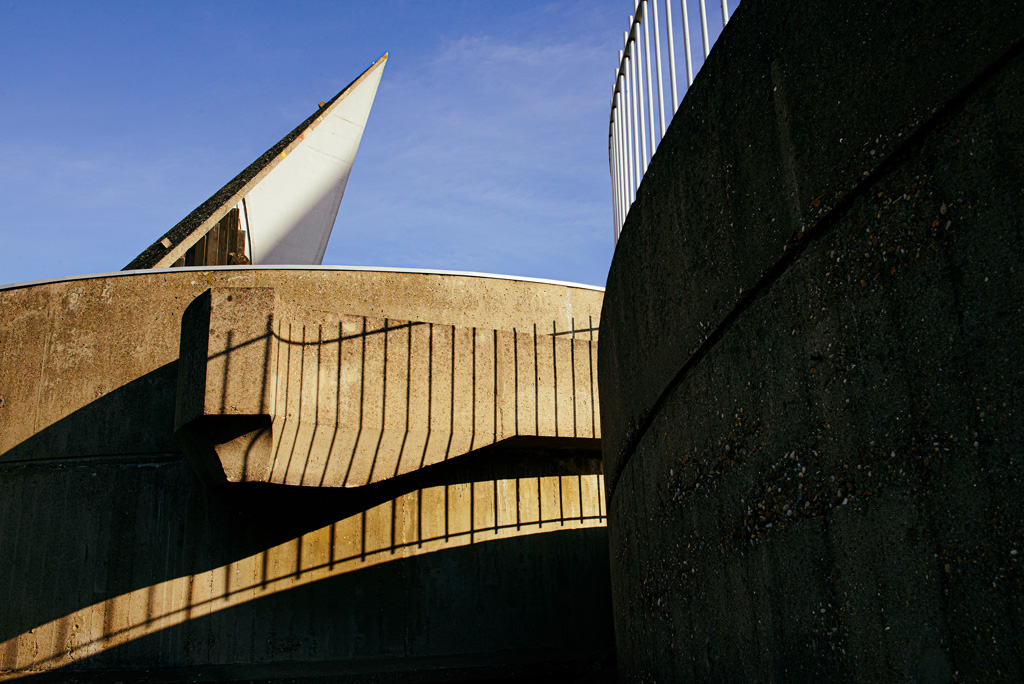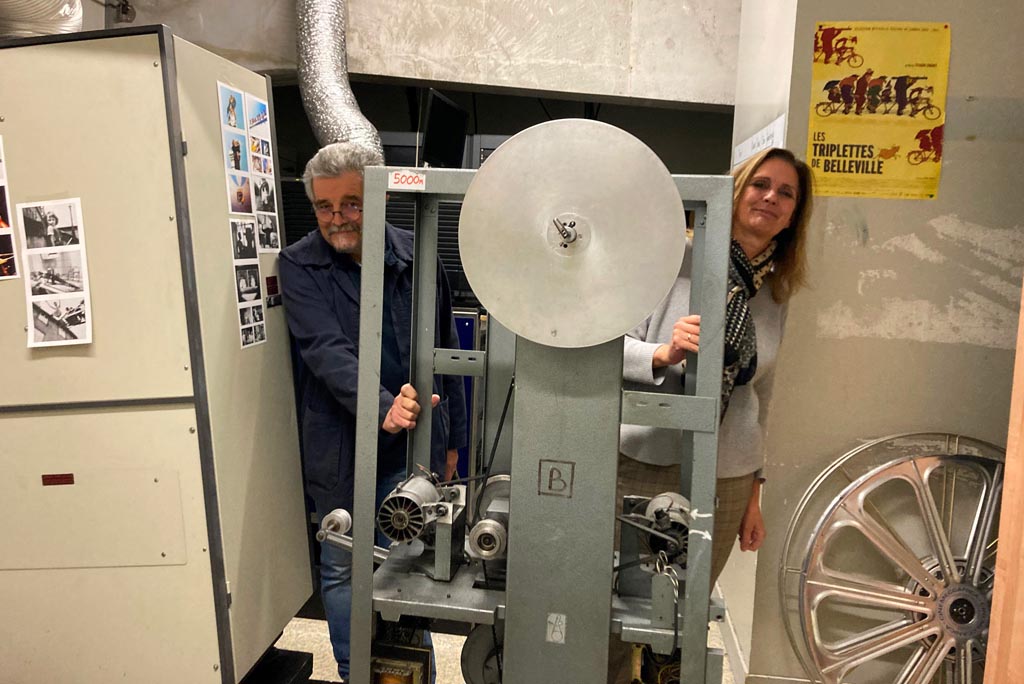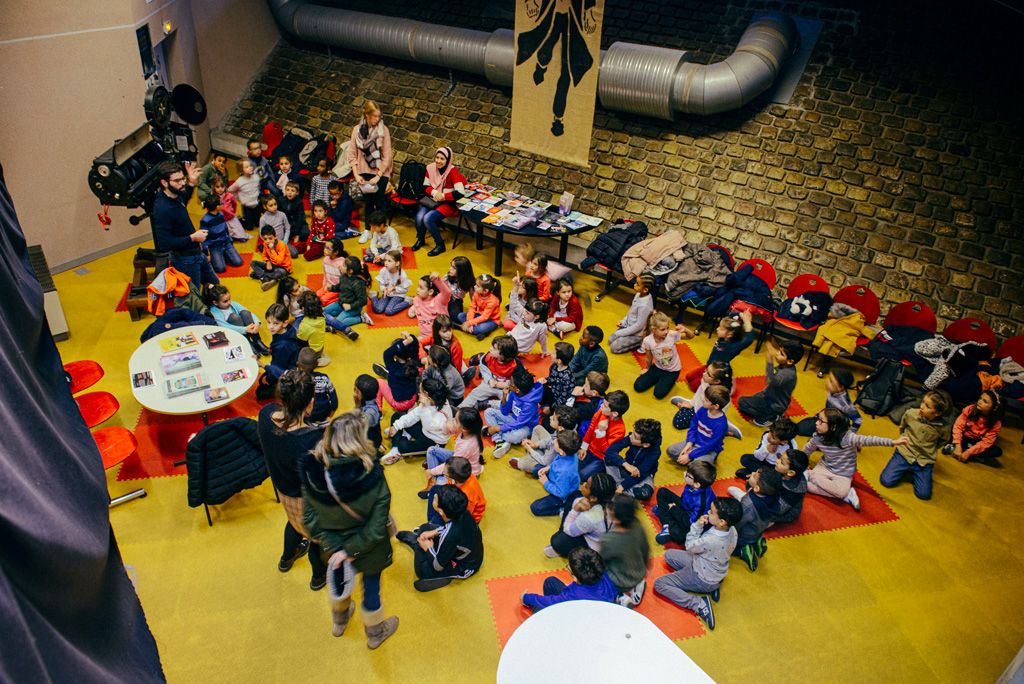03 Nov Cinéduchère, A beautiful story of the 7th Art!
By Nicolas Lepage, Payroll Manager at Fifty Bees & Claire Le Meur, CEO of Blue Bees
This week, the Bees met Georges Sothier and Emmanuelle Bureau, who passionately run CinéDuchère, an art-house movie theatre located in the 9th district of Lyon, which is celebrating its 25th anniversary this year…
Claire Le Meur: Can you tell us about the history of this amazing place?
Georges Sothier: Originally, in 1992, I had a small restaurant in La Duchère, which no longer exists. We transformed a school building that was no longer in use into a restaurant. It was called La Foucade. It was a daytime restaurant where all the social workers came to eat. In the end, we served 70 meals every day. The sub-prefect of the city, the delegate of the DRAC came to eat regularly. We were 4 people and an apprentice. Then I was contacted to set up a cinema in La Duchère. I thought why not, it would be really nice!
CLM: Why would someone contact a restaurant owner to set up a movie theater?
GS: (laughs) In fact, we had set up the restaurant with social funds, with the social development of the neighborhoods, at the time. We were the “social component” of the whole of La Duchère. There was nothing else. We were the rallying point. We had links with the library and it was a person from the library who contacted me. We were also organizing music nights.
CLM: So there was already a cultural component to this adventure…
GS: That’s it. We also had the idea of creating a rehearsal space to bring in artists, but it never came to life. Cinema was one of my passions, along with singing and music.


CLM: Are you a musician?
GS: I am a singer! Unfortunately, I am not a musician… I sing a lot of French songs. Brassens, Brel, Anne Sylvestre. So I was contacted for the film project with some sort of logic. We started by conducting meetings in the restaurant in 1993. We did a survey among the residents of La Duchère, asking them to name the 3 films they wanted to see. When the cinema would be opened, we would show the 3 films which were the most successful! For two years, we looked for places. We thought of a gymnasium, next to a school, other places as well.
Nicolas Lepage: You had been contacted to set up a cinema, without any idea of a place? That’s surprising…
GS: Yes! In 1995, the European projects for the transformation of La Duchère arrived, in the wake of the city policy. There was a program called FEDER which financed projects, including the one we were going to use: a church from the 70s had just been desecrated to show 3D cinema, as part of a project for children. The structure was called Captiva. In the hall, there was a huge ant, a construction site with foam bricks, etc. The idea was to create a mini “Villette”, like in Paris. The cinema ran about 3 times ten minutes a day.
NL: Why so little time?
GS: Because they were hosting groups of children and at the end of the exhibition tour, which lasted about an hour, they would play them 10 to 15 minutes of 3D short film. The problem was that they couldn’t fill it. The maximum broadcasting was five screenings in a day, until 5 p.m. As the place was closed in the evening, we thought that we could perhaps show some films… As we had an association, of about fifteen people, we were able to discuss with the town hall, which was very reluctant and finally accepted. Our first screening took place on May 8, 1996.

NL: What was the first film you screened?
GS: Toy Story. It was a success right away (laughs). Especially since there hadn’t been a cinema in La Duchère since 1975. From the start, we had a lot of people… The movie had just come out.
CLM: But why was the city council initially reluctant to the project?
GS: Because culture was not their major subject… They were concentrating on what had become urban social development, essentially focused on the repair of buildings, on real estate. They were not very interested in anything else.
NL: So there must have been very little life in the neighborhood.
GS: No, there has always been life in this neighborhood. Because there were two social centers, a children’s center, an MJC (Youth Cultural Center), a library. In the FEDER project, there was for instance the Lego house. They had put a mountain of Lego in a room and the children came to build things. I don’t know what happened to those Lego! There was also a brasserie-restaurant project. Our restaurant had closed in 1995 and I had made a proposal to take over this establishment in bad condition, for the same price as the brasserie-restaurant project. We had planned to redo the building. Our project was not accepted, despite the support of the sub-prefect of the city and the mayor of the district at the time, who was called… Gérard Collomb. But the funds went to the FEDER project. The brasserie-restaurant project lasted 6 months… The neighborhood in which it was set up was complicated… You don’t just set up a restaurant like this in La Duchère!
CLM: So you started the cinema adventure in 1996…
GS: Yes, despite the skepticism of the town hall. Then 1998 arrived. All of a sudden, we no longer had a director… The group that had partly created the cinema decided to abandon the project to invest in a research cinema project – which was not at all appropriate to the context of La Duchère. That’s how I ended up appointed president of the movie theatre (laughs). There were three of us: Marie, who is still our accountant, a projectionist and me! We went on like that for a few months. Then came the “youth jobs”, in September 1998. We recruited a young man, aged 29: Sami Bouguerch. He became the first film mediator! That was the title I had found. In fact, he was the director of the movie theatre (laughs). We were programmed by a group from the east of Lyon which included Vénissieux, Bron, Saint Priest and other cinemas. They made a common programmation to have more weight. The principle was that they gave us the left overs without much interest, after having made their choice (laughs). Our first preview was “Mister Frost”», a “technical release” film. That is to say that basically, one week after its release, the film was available on DVD!
Emmanuelle Bureau : If you wanted a specific film to be released nationally by a distributor, you had to take the whole list, at the time… For example, to get THE big film from Gaumont, you had to take the bad films that went along with it. It was a rather curious practice which dated back to the early days of cinema.

GS: Then we hired a second film mediator to deal with young people. Because the project was really to educate to the image. Sami was a film student and had a lot of knowledge about film, a lot of ideas, but he didn’t know anything about the organization of a cinema. He expressed his wish to tackle programming. So we said goodbye to the group and decided to do it ourselves! And it worked! We managed to get some nice movies despite the small size of our theater. The big change came in 2001, with the arrival of Gérard Collomb as Mayor of Lyon. All of a sudden, the situation was reversed… Our subsidies doubled and the people from Captiva, who used to welcome us by systematically undermining our efforts, became very nice… On December 24, 2002, Captiva team left, leaving everything (including the giant ant!). As the premises were empty, we moved into the offices and went on like that. We had signed agreements, notably thanks to Abel Gago, deputy mayor for culture and education, at the time. Louis Lévêque, who was at the central city hall, supported us and allowed us to obtain funds to buy a new screen. The existing screen was made for 3D and was “eating up” the light. We were also able, thanks to this support, to buy equipment for outdoor film projections. Sami had suggested that we buy the equipment rather than rent it. So we were able to become independent by owning our equipment.
NL: So you were also doing outdoor screenings?
GS: Yes, we did screenings in the summer, starting at 10pm. We did great screenings, especially on the terrace of the MJC, with an incredible view. The films were free, as part of “Tout l’monde dehors” festival. There were up to 300 people. It was really nice. But we sold the equipment a few years ago because it was 35mm equipment. It doesn’t work with digital anymore…
EB: It also required a large team of volunteers because we had to transport and set up all the equipment. We did the last screening with a 35mm print in 2012. It was memorable…
GS: Oh yes! (laughs) It was the screening of the Night of the Hunter. The film broke 15 times during the screening…
EB: The film had arrived in a poor state. The print had been damaged. The film had to be repaired the old fashioned way just before the screening. Despite that, the film kept breaking.
GS: And it was quite funny because every time the film broke, the 200 people present exclaimed with a big “Ooohhh” and then, when the projection started again, followed with a big “Ahhhh”. Incredibly, at the end, when the words “The end” appeared, the film melted! Genuine! Everyone applauded. This last session was quite exotic…
EB: We still organize outdoor sessions, but we now work with an external supplier. It’s easier for us in terms of organization. We would have to have someone full-time, dedicated to the subject, to deal with this ourselves.
GS: We love this popular cinema, as it was imagined in the beginning, in the 30s. I remember my mother telling me that when she went to the movie theatre at the Croix-Rousse – it was a parish cinema at the time – she would discover the news. This has remained in my head. At the time, the cinemas were full all the time…
CLM: It must be said that in those days, the price of a ticket was much cheaper. A cinema ticket is easily around 11€ now. That’s a lot of money…
GS: Yes, except here! Our full rate is 6€70… We have many links with partners, too. The Restos du Cœur, for example.
CLM: You’ve just passed a quarter century of adventure… What’s up for the next quarter century? What are your next crazy ideas?
GS: Actually Covid cut us off in our momentum… It’s been a tough reboot. We tried a lot of things, though, when we were forced to close because of the health situation. We organized movie games, for instance. We would show a small piece of poster and you had to guess the movie. Or, based on the “a contrario” game, we had people guess a movie title. The Night of the Hunter could become “The Day of the Fisherman”, for example. We did this for several weeks. We gave away 7 titles with 7 seats at stake for those who found all the titles, 5 seats if you found 5, etc. We stopped because people were getting too good at it (laughs). In the end, people were just playing for the beauty of it. We did our best to animate that time but we didn’t really dive into the thinking. We had the idea of creating a second movie room. We had put together a brochure which told the history of the place and what it could become.
CLM: A second movie room here?
GS: Yes, we have a first architect’s project for a second room with a capacity of 50 to 60 seats – we have a capacity of 90 seats in the current hall. It’s quite feasible. We have started to look for sponsors, contacted people to do a market study. We talked with Sainte Foy Les Lyon who successfully went from 1 room to 2 rooms – which allowed them to triple their attendance. They have around 90,000 spectators per year now.
CLM: How many spectators do you have here?
GS: Between 20,000 and 25,000 people a year. We hope to relaunch this project because the new Lyon City Council has planned to devote a budget for our venue. Our range of proposals, with two screens, could be wider. With one screen, we only show one film within 5 sessions.
EB: Especially since we organize evening debates at 7:00 pm with the people of the neighborhood. Scheduling a film at 9:00 p.m. at the back is useless. A second room would allow us to have a more diversified exploitation of our place. It would give us new perspectives and launch us into another dynamic.

NL: There is certainly some sort of frustration, too, with the fact of being unable to show as many films as you would like…
GS: Absolutely. Now we have to get the ball rolling again… But there is one thing to consider. I was 38 years old when I started the project. We were all in those ages. And now I’m the youngest! We didn’t find people to come and replace us… Sami had brought in young people when he first came. We thought that there would be a succession, fresh blood. He left to develop another project – a bit quickly, I must say. And the young people he brought along followed.
NL: Why haven’t you been able to attract other young people?
GS: Because it’s extremely difficult. The 15-25 age group is very difficult to attract here. Back then, when I was that age, I would actually go out to the movies, that is, to see the film. Now, young people go out to go out. They prefer to go to the cinema in the middle of Lyon, because there is the city around. You can go for a drink after the movie… That’s why we also have the idea, within the framework of the project for a second room, to set up a space where we can have a drink, exchange ideas after the film, and prolong the moment. That’s what we’re missing right now! Then we are mainly an art-house movie theatre – we avoid blockbusters ». And it’s the cinema we like! Our public corresponds to this. It’s the “Télérama” public (laughs).
EB: We also develop partnerships. With social centers, for example, we organize evenings talks. With the Centre Social de la Sauvegarde, for Halloween, we are going to organize an escape game which will be followed by a screening of Candy Man… It’s the first time we try this!
GS: We are also participating in Festival Lumière, with a screening. Then we have planned a Bertrand Tavernier weekend.
EB: We also have a small audience for our “CinéCollection”, with one or two screenings per month. We do a little debriefing before the film. And we must not forget the school audience, which makes up 35% of our admissions. We offer films for each cycle (school, college, high school) to educate young people about images, at the rate of one film per quarter.
GS: And, finally, we offer, on request – with the BTS courses, for example – à la carte screenings. We are happy to have an associative cinema that works! We have, notably thanks to subsidies, 6 salaried employees (projectionist, cultural mediator, accountant, service lady). We also have about fifteen volunteers who take care of the cash registers, the layout and distribution of the program, etc. There is a real osmosis between employees and volunteers. We all move in the same direction, following the same guidelines. It works very well and has for many years. Emmanuelle has been here for 14 years already! We have built up a great team, who are happy to come and work here. If the salaries are not great – I have to admit it! (laughs) – the project is quite interesting.
CLM: And what is the profile of your volunteers?
GS: They are, with two exceptions, ladies! I’m surrounded by ladies (laughs), most of them retired. The afternoon entries obviously can’t be run by people who work. We have a real collective thought. We want to share this second to none popular emotion. We don’t have an objective of figures, we are passionate…
Thank you to Georges and Emmanuelle for this wonderful testimony!
The Bees are happy and proud to accompany the CinéDuchère cinema every day and wish it to continue the beautiful dynamics of this adventure…
Photos © Simon Cavalier, Laurence Danière.

